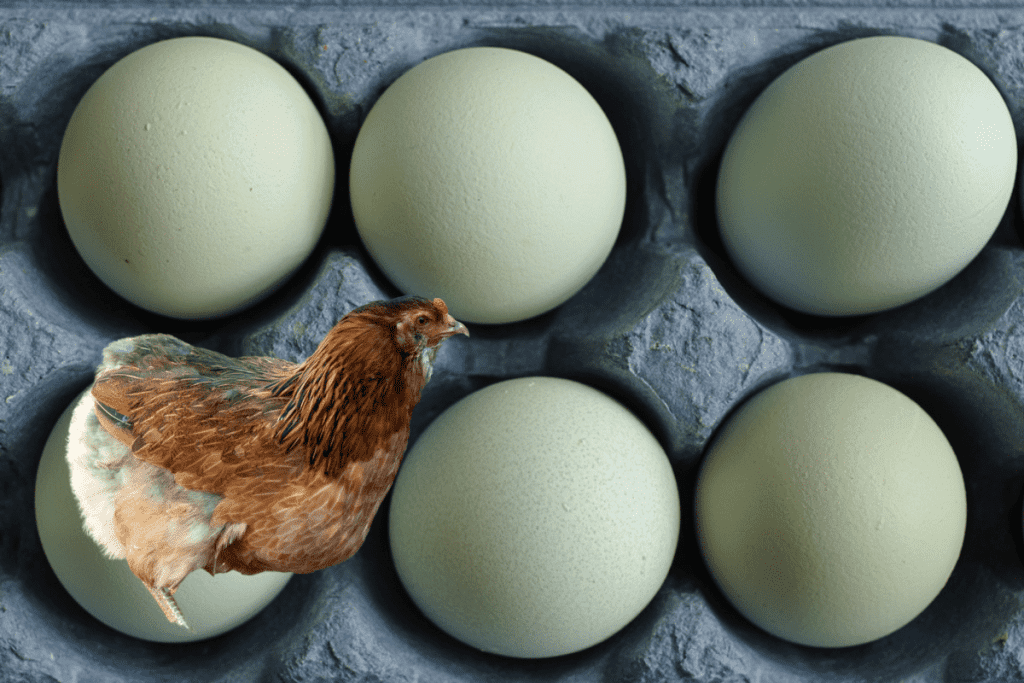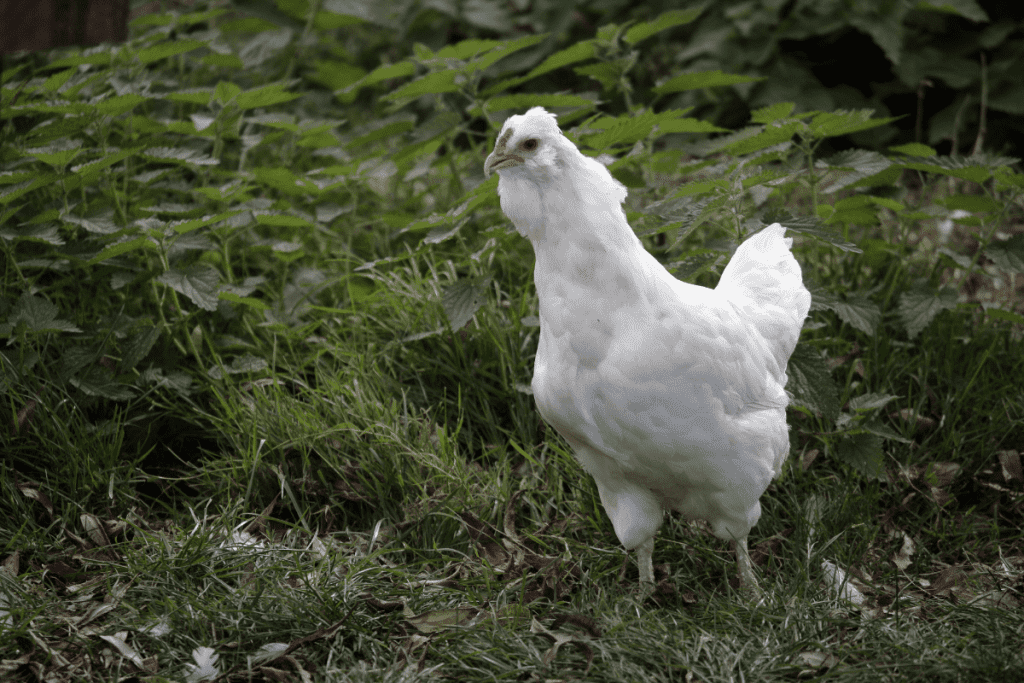An infamous layer of blue eggs, the Araucana chicken is a beautiful bird well worth adding to your coop.
These are flying chickens with sharp minds who originated in Northern Chile.
But many people are most excited about the shade of the Araucana’s eggs.
Keep reading to learn about the Araucana’s laying habits and eggs!

Table of Contents
ToggleWhat Do Araucana Eggs Look Like?
Araucana eggs are blue or bluish-green in color and medium in size. Their exact color and even size may vary slightly from bird to bird. However, these eggs are always beautiful!
Araucanas are not among the most common chicken breeds for small farmers, especially in the United States.
They are, however, one of only a few breeds who lay eggs of this color.
Most of your flock is probably laying brown and white eggs, making the Araucana’s eggs stand out.
Can Araucanas Lay Brown Eggs?
Araucanas do not lay brown eggs, only blue ones. However, the Araucana is a cross between two breeds with different physical traits. One of these chickens, the Quetro, shares the Araucana’s ear tufts but lays brown eggs.
Many backyard chicken owners aren’t familiar with the Araucana’s history.
However, getting curious about the birds you’re raising is always good!
The Araucana originated in Chile and was originally a cross between the Quetro and the Collonca.
If you or someone you know believed Araucanas laid brown eggs, the Quetro is probably who you think of.
They look very similar to the Araucana due to the unique physical trait of their ear tufts.
However, the Quetro lays brown eggs, and the Araucana’s eggs are blue.
What Makes Araucana Eggs Blue?
The pigment making Araucana eggs blue is called oocyanin. This pigment is applied to a developing egg during the laying process, which gives the shell its color. This is true for all blue-egg chickens.
The Araucana, in particular, was given this trait by one of their parent breeds, the Collonca, who also lay blue eggs.
When Do Araucanas Start Laying?
Araucanas start laying when they reach 20-24 weeks of age. This is later than many other chicken breeds, starting at 18-20 weeks. But it is perfectly normal for Araucanas to start later than most of your backyard flock.
Remember, many birds produce smaller eggs when they first start laying.
Sometimes the pigment of their eggs is lighter at first, too.
This is normal!
When chicks grow into laying hens, they simply aren’t big enough to produce larger eggs.
Araucanas are not particularly large birds, even at full size, weighing about five pounds when fully grown.
So, don’t be surprised if they lay small eggs for a few months.
Just enjoy those beautiful blue shells!
How Long Do Araucana Chickens Lay Eggs?
Araucanas can continue laying eggs for up to six years. Their laying will likely slow down after three or four years. But, like many other poultry breeds, they will lay for much longer before finally quitting.
If you take good care of your chickens, they will repay you with plenty of eggs for many years.
With Araucanas, the physical characteristics of their eggs make those years of laying all the more valuable.
What Ages Do Araucanas Lay?
Araucanas lay from the time they are 20-24 weeks old until they are around 6-7 years of age. While they start laying slightly later than many other poultry breeds, they lay for about the same amount of time as other breeds throughout their lifetime.
Every bird is different.
You may have an Araucana who starts laying a little earlier or later or stops laying sooner or later than expected.
The joy of being a chicken keeper is seeing your adult birds grow into individuals, developing at their rate and even displaying some real energetic personalities.
The Araucana, in particular, is the perfect bird for this.
Their confident but amiable personalities and wit make them interesting and pleasurable birds to have around.
How Many Eggs Do Araucana Chickens Lay?

Araucanas are impressive layers, producing about 4 eggs per week or 200-230 eggs yearly. While this is much less than breeds like the Brahma or Rhode Island Red, it is on par compared to other blue-egg chickens such as the Cream Legbar.
It is difficult to find blue chicken eggs, so the Araucana’s egg production is very good.
This is enough to keep different colored chicken eggs filling your fridge regularly!
Do Araucanas Lay in the Winter?
Araucanas are hardy birds who lay even in the winter. They slow down in the colder months but continue to produce eggs, and when spring rolls around, they are one of the first to speed back up again.
Considering they originated in South America, it is surprising how well Araucana hens handle cold weather.
Their feathers protect them better than you might expect, which means they can lay better than some hens do in the winter months.
The Araucana’s pea comb is also less susceptible to frostbite than larger combs such as those Leghorn hens have.
That said, they bear the heat equally well, if not better.
They use their flight feathers when it’s warm outside and enjoy flying over fences and being mischievous.
Just like any other breed, they need access to shade, cool water, and plenty of space.
But they bear the heat well!
How Long Do Araucana Eggs Take to Hatch?
Araucanas are very difficult to hatch, and many chicken enthusiasts have been disappointed to hatch only a few eggs when they expected a large clutch of chicks. When they do hatch, Araucana eggs usually take about 22 days.
It’s always good to be careful who you buy hatching eggs from, as it is common to receive duds when ordering by mail.
However, with Araucanas, only trust the best.
Hatching Araucanas is next to impossible.
Only a few will hatch in a dozen eggs, and you have to be very careful to even get those few chicks.
If this is your first time hatching eggs, it’s probably best to start with another breed. Araucana eggs are a real challenge.
Don’t be afraid to simply buy from commercial hatcheries.
Do Araucana Hens Go Broody?
Many experienced chicken keepers will tell you broodiness depends on the bird more than the breed. Some say Araucanas are extremely broody, and others have never had a broody hen. Broodiness in Araucanas is more of an individual trait than a breed trait.
This being said, even a broody Araucana may not give you any trouble when you go to collect the eggs.
Frequently, Araucanas don’t like to be touched and will flee the nesting box when you reach into it.
Don’t trust your hens with this task when it comes to hatching eggs.
Araucana eggs, as previously stated, are notoriously difficult to hatch, even using an incubator.
Further Reading: Do Araucana Chickens Go Broody?
More About the Araucana Chicken
The Araucana has much more to offer than blue eggs. They have beautiful feather plumage and wonderful personalities. They are docile by nature but confident and unafraid to cause a little mischief now and then. Their flying ability is impressive as well!
Araucanas are not cuddly cuties like Silkies.
However, they are not usually aggressive toward people either.
They like their space, so don’t expect your Araucana to let you pick her up and snuggle.
She won’t display behavior issues if you respect her space.
Some Araucanas warm up to people and eventually let you hold them.
But respect their preferences and don’t pick them up if they don’t like it.
Araucanas are generally confident and like to explore and forage.
This is why you need to allow them plenty of space to roam if you add any to your flock.
Physically, the Araucana’s defining characteristic is probably their ear tuft trait.
This sets them apart from many common backyard chicken breeds.
They also have a pea comb and come with many types of pretty feather patterns.
Araucanas are healthy birds for the most part.
However, as chicks, they are more vulnerable than some other breeds.
We know it is hard to hatch Araucanas, but it is also sometimes hard to get them through the first few weeks of life.
Araucana chicks have an especially high mortality rate if they aren’t bred properly.
They tend to live for 7-8 years on average.
Araucana Roosters
Unlike the hens, Araucana roosters are sometimes quite aggressive.
Their confident nature can turn them into bullies if they aren’t kept separate from pullets and other vulnerable birds.
They weigh about 6.5-7 pounds at full size, whereas hens weigh closer to 5.5 pounds.
If you want to breed your hens or enjoy showing chickens, you may keep a rooster.
Otherwise, they are not the friendliest birds to have around.
How useful was this post?
Click on a star to rate it!
We are sorry that this post was not useful for you!
Let us improve this post!
Tell us how we can improve this post?
